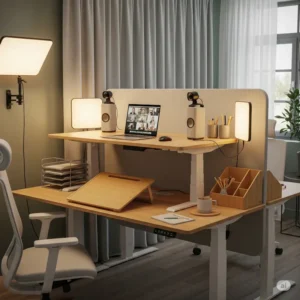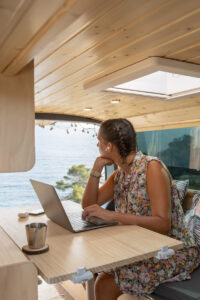As remote work becomes the norm, both beginner bloggers and seasoned digital nomads are rethinking what it means to work efficiently outside of a traditional office. Having the right remote work essentials isn’t just about comfort—it’s about staying productive, professional, and connected no matter where you are.
Whether you’re setting up a home office or managing a full-time blog while traveling, this guide covers the key tools and setups you’ll need in 2025.
Building a Productive Work-from-Home Setup
A solid workspace starts with basics like ergonomic furniture and high-speed internet. But to really thrive from home, your work from home equipment checklist should include:
- A comfortable chair that supports long hours
- An adjustable desk or standing desk converter
- Dual monitors or a large external screen
- A laptop stand and external keyboard
- Good lighting to reduce eye strain and improve video calls
- Backup power solutions like a UPS or portable battery pack
A well-thought-out environment contributes to your overall ability to focus. Many new bloggers setting up a home workspace find themselves also exploring how to start a blog, so building that space with long-term goals in mind pays off.
FAQ
What do you need for a WFH setup?
Core equipment includes a laptop, desk, ergonomic chair, reliable internet, and accessories that improve focus and efficiency.
Must-Have Tools for Digital Nomads on the Move
Working from anywhere introduces challenges that home-based workers don’t always face. Travelers need gear that’s light, durable, and globally adaptable.
Essential remote work tools for digital nomads often include:
- A compact, high-performance laptop
- Universal power adapters and surge protectors
- Lightweight portable monitors
- Travel-sized ergonomic accessories
- VPN software and encrypted cloud storage
For those balancing client calls in Bali or writing deadlines in Lisbon, making sure your gear meets remote work requirements across different countries is critical. It also helps to consider destinations where connectivity and infrastructure support long-term stays, as explored in our guide to the best destinations for digital nomads.
FAQ
What should I put for a remote work location?
You can list any space that supports your workflow—co-working hubs, dedicated rentals with desks, or even flexible cafés with strong Wi-Fi.
Personalizing Your Space with Useful Extras
Once the core setup is in place, many remote workers add touches that reflect their personality or improve daily comfort. These fun work from home accessories blend form with function:

- Smart speakers for timers and music
- Lap desks and adjustable risers
- Desk organizers made from natural materials
- Stylish webcams and lighting setups
- Noise-blocking curtains or room dividers
If you’re someone who enjoys refining your workspace, you might also be interested in the essential tools for content creators, which cover both functional and creative enhancements.
Software and Systems for Staying Organized
Having the right tools extends beyond hardware. Productivity and communication platforms are critical for staying on top of projects and maintaining professional standards.
Popular platforms include:
- Notion and ClickUp for task management
- Slack and Zoom for communication
- Google Workspace or Microsoft 365 for collaboration
- Krisp for filtering background noise
- Reliable VPNs and encrypted cloud storage
As you streamline your workflow, you may naturally begin incorporating more advanced systems—many of which are discussed in our overview of automation and AI tools for bloggers.
Creating a Flexible Workspace in Any Environment
Whether you’re renting a room for a month or hopping between Airbnb listings, you can still create a reliable setup with a few thoughtful additions:
 A compact cable management kit
A compact cable management kit- Portable desk lighting
- Foldable laptop stands
- Adjustable office chairs (or at least ergonomic cushions)
- Room dividers for separating work and leisure
Many remote workers develop a mobile version of their work from home necessities, allowing them to set up in cafés, libraries, or temporary rentals. If you’re working while traveling, managing resources and expenses becomes just as important—especially when it comes to managing finances while traveling.
FAQ
What equipment do you need to work remotely?
At minimum: laptop, headphones, webcam, and internet access. Add ergonomic tools and backup systems as needed.
Your Go-To Checklist for Remote Work in 2025
Here’s a streamlined checklist of must haves for work from home and mobile productivity:
- Digital NomadsErgonomic chair and adjustable desk
- Noise-cancelling headphones
- High-speed internet + mobile backup
- Lighting setup for calls and focus
- VPN and cloud storage
- Power adapters and surge protection
- Task management and communication tools
- Portable gear for travel
- Soundproofing or distraction blockers
These are the same items we see discussed regularly in communities of bloggers and freelancers who balance full-time travel and content creation.
Real-Life Setups: Inspiration from the Remote Work Community
It’s always helpful to see how others make it work. Remote professionals across the globe have adapted their spaces in creative ways:
- A minimalist desk in Mexico City outfitted with nothing more than a MacBook, AirPods, and a sturdy chair
- A full dual-monitor setup in a van parked along Portugal’s Algarve coast
- A pop-up standing desk in a Tokyo apartment, made from stacked books and determination
Many of these setups are featured in community discussions about wfh must haves—which, interestingly, often reflect broader themes in how bloggers approach writing engaging content in their remote lifestyles.
Final Thoughts
Your remote work setup doesn’t need to be complicated—but it does need to support your lifestyle and career goals. Whether you’re crafting articles from a cozy apartment or managing a client list from a hostel in Thailand, your remote work essentials should evolve as you do.
The good news? You don’t have to do it alone. Voyager.ink is a place to connect with others building businesses and blogs from anywhere. Create a free profile, showcase your workspace, or start your own WordPress-powered blog to bring your ideas to life.


